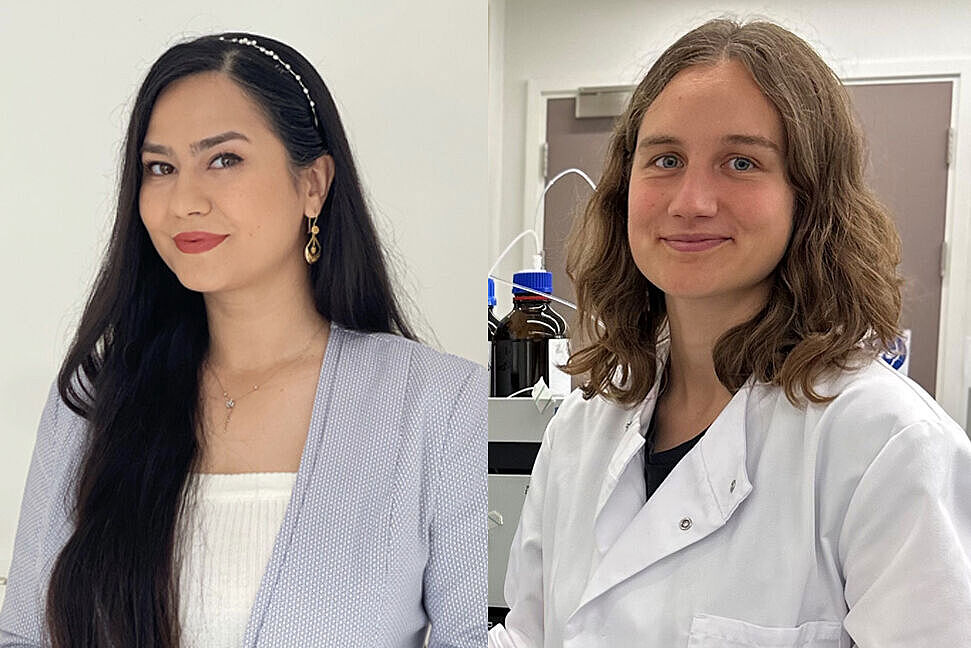As different as their works are, they have one thing in common: they literally “light up” cutting-edge technologies. Dr. Nasibeh Haghighi develops novel laser diode structures for illumination, object detection and tracking. Dr. Carla Kirschbaum combines mass spectrometry and infrared spectroscopy to detect the finest differences in lipids, which can be used, for instance, to identify altered molecular structures in cancer cells. The ceremony for the Marthe Vogt Award, which is accompanied by €3,000 each in prize money, will take place during “Berlin Science Week” on November 8 at 6 pm in the Leibniz Association headquarters in Berlin-Mitte. Dr. Bahar Haghanipour, Vice President of the Berlin House of Representatives, is expected to be the ceremonial speaker.
"Nasibeh Haghighi is a pioneer in the field of vertical cavity surface emitting lasers (VCSEL). Her interdisciplinary approach enables her to achieve record values in the combination of optical output power, bandwidth, and efficiency, which will be essential for use of this technology in society," wrote the award committee. The physicist designed, fabricated, tested, and analyzed VCSEL laser diode arrays, which are made of nanometer-thin crystalline semiconductor layers of aluminum gallium arsenide and include thin gold electrical contacts. Smaller than the head of a pin, they are extremely fast, efficient, and can be manufactured in large quantities. In the future, they could be used as sensing eyes in robotic manufacturing, for free-space communication links, for virtual and mixed reality, and in autonomous vehicles. Wireless Fidelity (WiFi) and cellular networks will be able to transmit data 10 to 100 times faster and more energy efficiently with VCSEL light sources. They are already being developed into products by industry.
Nasibeh Haghighi impressed her Ph.D. supervisor, Prof. James A. Lott, not only with her excellent research, but also with the perseverance and energy with which she pursues her path. A chemist from the Kurdish area of Northwestern Iran, she studied at universities in Kermanshah and Sanandaj – graduating in the top 5 %. While completing her master's thesis, she moved to Tehran where she founded a startup, and then decided to pursue a Ph.D. at a European university. She started it in 2017 at the Technical University of Berlin as a key part of the Collaborative Research Center 787 project "Semiconductor Nanophotonics: Materials, Models, Devices," funded by the German Research Foundation. In December 2021, she received her doctorate (summa cum laude) and immediately started a postdoc position at the Ferdinand-Braun-Institute in Berlin.
Where does she get her energy? "I have an incredibly close and supportive family that values education, community, and adventure“, says Nasibeh Haghighi. The Marthe Vogt Award, she explains, encourages her to keep working hard, dreaming, and taking the road less traveled. "I am very grateful to Germany and its people for funding my research and giving me the opportunity to experience life in Europe." Dr. Haghighi is staying in Germany and is now a project leader for laser chip development at ams OSRAM in Regensburg.
For the second winner, Carla Kirschbaum from Berlin, it all started with complicated math problems in school. Staying with theoretical problems until she understood and solved them was her favorite. She studied chemistry at the Free University of Berlin and went to Paris for research internships at the École Normale Supérieure and the Sorbonne during her master’s studies. She completed her Ph.D. at the Free University of Berlin and the Fritz Haber Institute of the Max Planck Society (summa cum laude) in March 2023 - at the age of only 25.
Carla Kirschbaum has developed innovative approaches to the complex structural analysis of lipids. "She has impressively demonstrated that diagnostic details can be derived from the smallest biological sample amounts using infrared spectroscopy," says the award committee. With more than half of approved drugs targeting membrane proteins, Kirschbaum's method is highly relevant for identifying lipids that specifically bind to these proteins and modulate their function, the jury appreciated.
The problem with lipids: They often have the same mass but different structures. Examples of such isomers are omega-3 and omega-6 fatty acids, which differ only in the position of the first double bond in their lipid chain. Standard analytical methods such as mass spectrometry fail here. In the case of glycolipids, the connection between the lipid and the sugar residue determines their three-dimensional shape in such a way that their function in the cell can be completely different.
"Infrared spectroscopy is very sensitive to the chemical environment of oscillating atoms and the infrared spectra of isomers look very different," explains Carla Kirschbaum. For her "lipid fingerprint analysis", the researcher freezes the samples in superfluid helium droplets and hits them with an infrared free-electron laser. The irradiation excites molecular vibrations in the lipids, which are registered by a mass spectrometer. In this way, disease-related changes in fatty acids can now be identified even in very small sample amounts.
Kirschbaum's mentor, Prof. Kevin Pagel, sees her as "a born scientist". She is able to quickly grasp complex relationships and use her sharp mind to critically question dogmas. Carla Kirschbaum is now a researcher at University of Oxford, where she studies the interactions between membrane proteins and lipids. What does the award mean to her? "It is a great honor for me - especially since I did my Ph.D. at Max Planck, which is sort of a competitor organization."
The Marthe Vogt Award recognizes outstanding doctoral theses by female researchers in fields in which the institutes of the Forschungsverbund Berlin also conduct research. However, the work does not have to originate from there. The Award commemorates the German pharmacologist Marthe Louise Vogt (1903 - 2003), whose work contributed significantly to the understanding of the neurotransmitter adrenaline.
Text: Catarina Pietschmann


